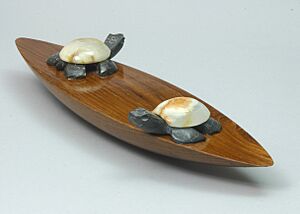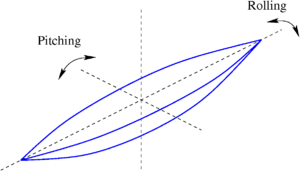Rattleback facts for kids
A rattleback is a special kind of spinning top. It looks like a curved boat or a half-egg. When you spin it in one direction, it spins normally. But if you spin it the other way, it starts to wobble, slows down, stops, and then magically spins back in its preferred direction!
This strange behavior seems to break a rule of physics called the conservation of angular momentum. This rule says that spinning things should keep spinning in the same direction unless something outside makes them change. Rattlebacks are so unusual that people have been fascinated by them for a very long time, even since ancient times.
Contents
What is a Rattleback?
Other Names for Rattlebacks
Rattlebacks have many different names! Some people call them "anagyre," "Celtic stone," or "druid stone." Other fun names include "rattlerock," "Robinson Reverser," and "wobble stone." You might also see them sold as toys with names like "ARK," "Bizzaro Swirl," or "Space Pet."
How Rattlebacks Look and Feel
Sizes and Materials
Rattlebacks can be found in many sizes and made from different materials. Ancient ones were often made of stone. Today, many are sold as toys and are made of plastic. These plastic ones are usually about 3.75 inches (about 9.5 cm) long.
You can also find carved wooden rattlebacks, which are a bit longer, around 5.5 to 6 inches (about 14 to 15 cm). Some very large ones have been made for science museums. These can be up to 8 feet (about 2.4 meters) long!
Different Designs
There are two main ways rattlebacks are designed. Some have a base that isn't perfectly even, which makes them roll a bit crooked. Others have a base that looks even, but they have hidden weights inside placed off-center at the ends. Both designs help create the rattleback's unique spinning trick.
The Science Behind the Spin
Why It Reverses Spin
The rattleback's spin reversal happens because of tiny wobbles and tilts. When you spin it, it doesn't just spin around. It also starts to roll (like a boat rocking side to side) and pitch (like a boat tilting front to back).
If the rattleback's weight isn't perfectly balanced, these wobbles and tilts can get bigger. This uneven weight makes the spinning motion connect with the tilting motion. It's like the tilt pushes the spin in a new direction. This push gets stronger and stronger until the rattleback stops and spins the other way!
Why Only One Way?
Most rattlebacks only reverse their spin when you spin them in one specific direction. This is because the wobbles and tilts grow much faster in that "strong reversal" direction. When you spin it the other way, the wobbles grow very slowly. Friction and air resistance usually slow the rattleback down and stop it before it has a chance to reverse.
However, some special rattlebacks are designed to reverse no matter which way you spin them. They might even reverse several times in a row!
Making it Move in Other Ways
You don't always have to spin a rattleback to make it move. You can also make it react by:
- Tapping it: Gently press down on one of its ends for a moment.
- Rocking it: Press down repeatedly on one of its ends, like you're rocking a cradle.
Images for kids
See also
 In Spanish: Peonza celta para niños
In Spanish: Peonza celta para niños




